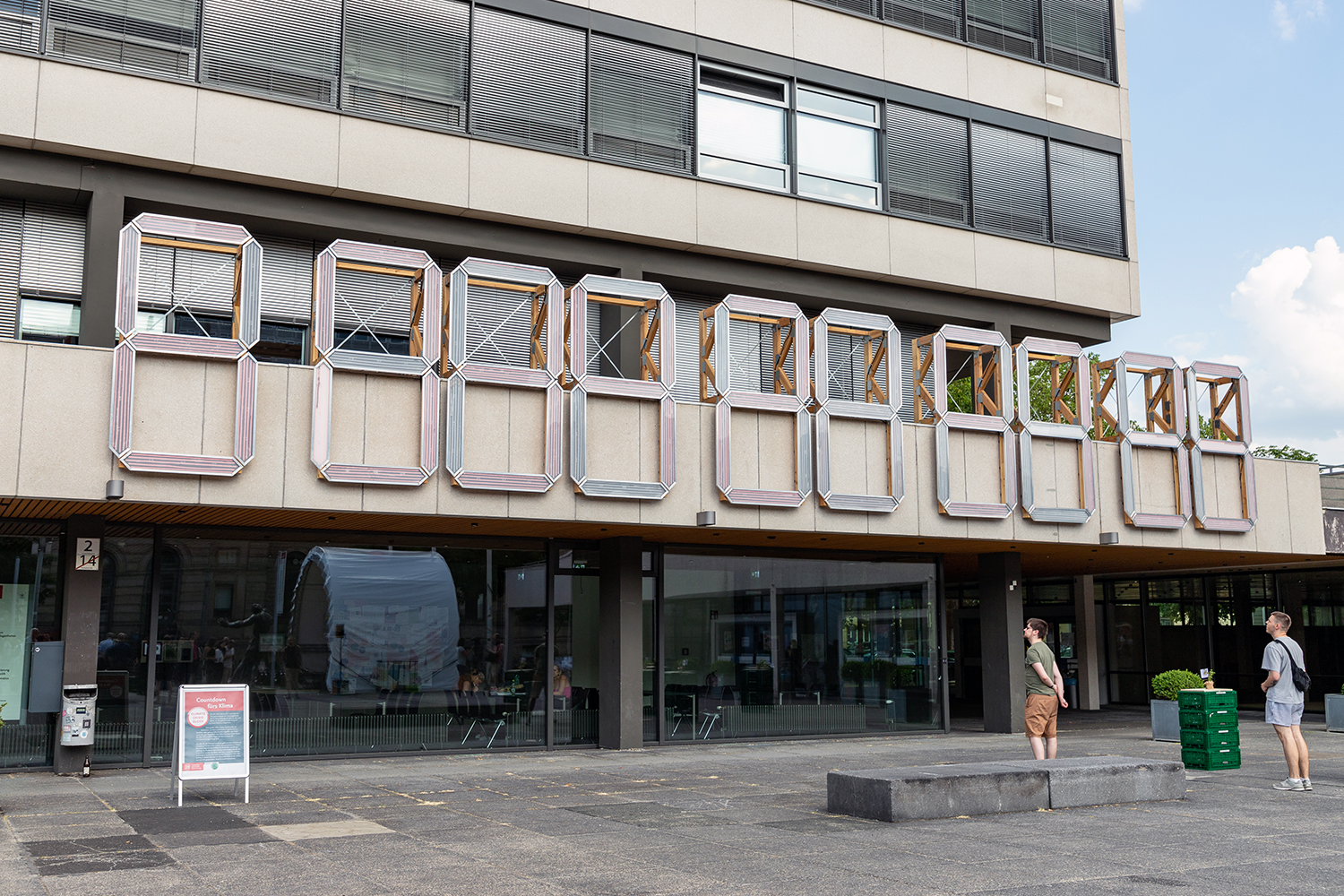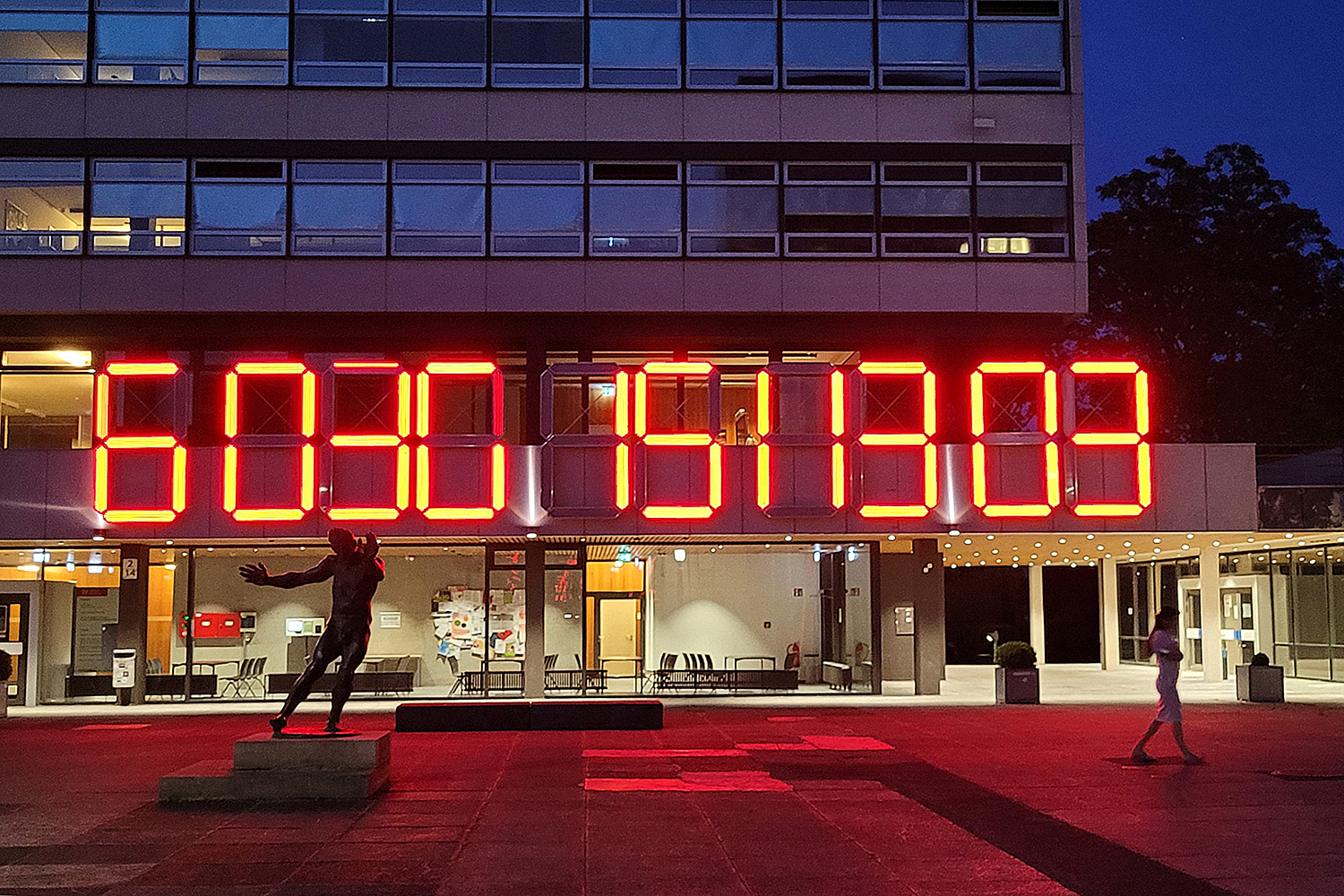ClimateCrisisClock will be dismantled Technical defects after water damage cannot be repaired
It was a memorial that signalled the countdown for the climate on TU Braunschweig’s Forum Building. Now the ClimateCrisisClock is being dismantled again. Following water damage caused by heavy rainfall last summer, the climate clock had to be switched off for safety reasons. There were also other technical defects that could only be repaired at great expense.

The ClimateCrisisClock was launched on 15 June 2023 as part of the TUmorrow Days. Photo credit: Kristina Rottig/TU Braunschweig
“The ClimateCrisisClock was and is an excellent idea, and a lot of forward-looking conviction and passion went into its implementation,” says Professor Manfred Krafczyk, Vice President for Digitalisation and Sustainability. “Unfortunately, the challenges of such a project are difficult to realise for a robust and permanent external operation with student resources. We are currently investigating the realisation of an alternative, leaner implementation to stabilise at least parts of the original concept.”
With the ClimateCrisisClock as a central element on campus, TU Braunschweig wanted to raise awareness of the urgency of action. The clock showed the time left to limit global warming to 1.5 degrees Celsius. The idea came from the climate justice movement “Students for Future”. More than 60 Architecture students and the student engineering office StudING were involved in the development of the clock – from design and implementation to final assembly at the end of April. Right up to the end, TU Braunschweig was looking for ways to repair the ClimateCrisisClock at a reasonable cost.
In the rooms of the Institute for Architecture-Related Art (IAK) in Querumer Forst, the students assembled the ten large numbers from material, some of which was donated. As part of the TUmorrow Days, the ClimateCrisisClock was finally launched on 15 June 2023 and counted down the time in rapid steps on the Forum Building.

Ten large numbers form the ClimateCrisisClock, which counts down the time in rapid steps. Photo credit: Kristina Rottig/TU Braunschweig
Sculpture not to be missed
For Professor Folke Köbberling of the IAK, this is a “great self-organised student project”: “A site-specific sculpture that reacts formally to the Forum Building and also works without the glow of the numbers. Without the concrete time specification, everyone can take their own perspective on this urgent issue.” The students have learnt a lot from the project, she says, not only about craftsmanship, soldering and organisation, but also that not everything always goes smoothly. “A big thank you to all the students and especially to Kathrin Philipps, Mia Gutschalk and Florian Potkowa, who put their heart and soul into the ClimateCrisisClock,” Folke Köbberling emphasises.
In a statement, the student co-initiators regretted the dismantling of the clock: “We are deeply saddened that the ‘ClimateCrisisClock’ project on the Forum Building has to come to a premature end. Especially that our climate memorial was only able to spread its message for a short time,” wrote Kathrin Philipps, Mia Gutschalk and Florian Potkowa on behalf of the students involved. “Nevertheless, as student co-initiators, we are more than grateful for the shared experiences we were able to gain through the project work.” Thanks to the commitment of many supporters from different faculties, it has been possible to create an installation that communicates about climate change and to raise public awareness of the issue. The dismantling of the clock will not be the end of the project.
Clock returns to the cycle
“We will use the knowledge gained as a basis for future projects,” say the students. “We hope that the ClimateCrisisClock has raised awareness of the climate crisis and that it will inspire many other projects in this field. The rapid pace of global warming and its explosive nature are hard to ignore. As the years, days, minutes and seconds tick away inexorably, the clock is still ticking. Together, we can make a difference.“
This is why the ClimateCrisisClock does not end up in the rubbish when it is dismantled, but returns to the cycle. The material will continue to be used by the Institute for Architecture-Related Art. The idea of the IAK team: “We will transform the clock and use the wooden structure for the facade of the institute.”
